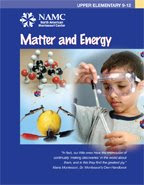Recently, my son greeted me with “Mom! I need you to sign my sheet for the science fair”. As I looked over the permission slip, I noticed there was a space where he needed to fill in his topic. When I asked what experiment he would be testing, he looked at me with a young adolescent stare and shrugged his shoulders. “I dunno”. Rather than get upset with his lack of preparation, I suggested we take a look through my NAMC science manuals.
Although he’s in 7th grade, I began by giving him my lower elementary manual to look through. He methodically turned the pages, engaged by the variety of experiments and really took his time reading and looking at the pictures. Then, he took a look through my
NAMC Upper Elementary - Scientific Method and Technology manual. He read through it, closely studying the section on science experiments and experimental variables.
Montessori Curriculum Resources - NAMC Scientific Method and Technology Manual
After looking through the manuals, he asked about the Upper Elementary Curriculum Support Material CD-ROM I had brought downstairs along with the two manuals. We put it in the computer and went through it together. Even though I've looked at the CD before, and even printed some of the charts for my own use, it still amazes me that there is so much information on it. We looked through the diagrams of flowering plants and trees, charts that show- the relationships between different plant groups, characteristics of monocotyledons and dicotyledons, Linnaean classification, parts of the root, stem, leaf, flowers and fruit.
I’d given him a pad of sticky notes when we began, and observed that he had chosen three experiments that both interested him and could be slightly modified for middle school. After some discussion, he chose Experiment 7 in the Botany section of the lower elementary manual, “Growing Plants without Soil”. He commented on how we’d seen hydroponics and aeroponics in action during our trip to Epcot last Christmas and how it seemed that this would be a good experiment that he could conduct over Christmas Break. I agreed and we started making plans on how best to conduct the experiment.
Permission completed and signed, he asked if he could keep looking through the CD-ROM since there was “so much good information on there”. He spent the next bit reading the charts and support material for the Upper Elementary Physical Geography, Zoology, and even World History manuals.
I find myself doing the same thing when I look through the teaching support materials that NAMC provides along with their manuals. Truly, they thought of everything I need to teach my class! And the best part is, I don’t have to spend the time making them myself. I simply print it on cardstock from the CD, mount it on colored cardstock and laminate it using my small home laminator. It’s easy enough to do in the evenings or on weekends and quick enough where I still have time to spend with my family. Since the materials are in full-color, I’m not wasting time coloring them myself. My students love them and compliment me when I put new work on the shelves.
I’ll be writing more on how to make beautiful, lasting materials for your Montessori classroom. Until then, take the time to look through what it is you need or want to make. Then, make the commitment to do a little at a time. Remember, you don’t have to make all the materials at once. Each level is for a 3-year continuum. If you make a little at a time, in three years you should have a complete classroom set.
View NAMC's Lower Elementary Science Experiments - Table of Contents.
 View NAMC's Upper Elementary Botany & Microscopic Study - Table of Contents, as well as Sample Curriculum Support material.
View NAMC's Upper Elementary Botany & Microscopic Study - Table of Contents, as well as Sample Curriculum Support material.

 View the full range of NAMC's Montessori curriculum - over 40 manuals and additional resources!
View the full range of NAMC's Montessori curriculum - over 40 manuals and additional resources!
As much as possible, NAMC’s web blog reflects the Montessori curriculum as provided in its teacher training programs. We realize and respect that Montessori schools are unique and may vary their schedules and offerings in accordance with the needs of their individual communities. We hope that our readers will find our articles useful and inspiring as a contribution to the global Montessori community.
© North American Montessori Center - originally posted in its entirety at Montessori Teacher Training on Monday, January 5, 2009.
 View NAMC's Upper Elementary Botany & Microscopic Study - Table of Contents, as well as Sample Curriculum Support material.
View NAMC's Upper Elementary Botany & Microscopic Study - Table of Contents, as well as Sample Curriculum Support material.
 View the full range of NAMC's Montessori curriculum - over 40 manuals and additional resources!
View the full range of NAMC's Montessori curriculum - over 40 manuals and additional resources!



0 comments:
Post a Comment
Have questions or comments? Let us know what you thought about this article!
We appreciate feedback and love to discuss with our readers further.